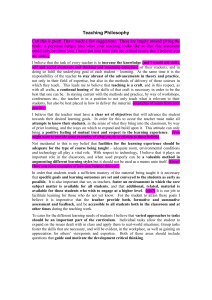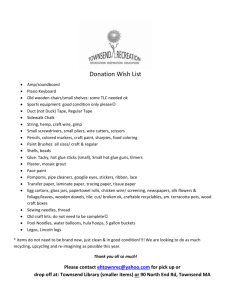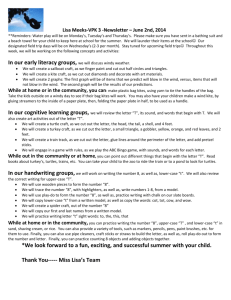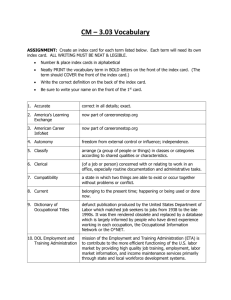OTPF-III Activity Analysis: Craft & Everyday Skills
advertisement
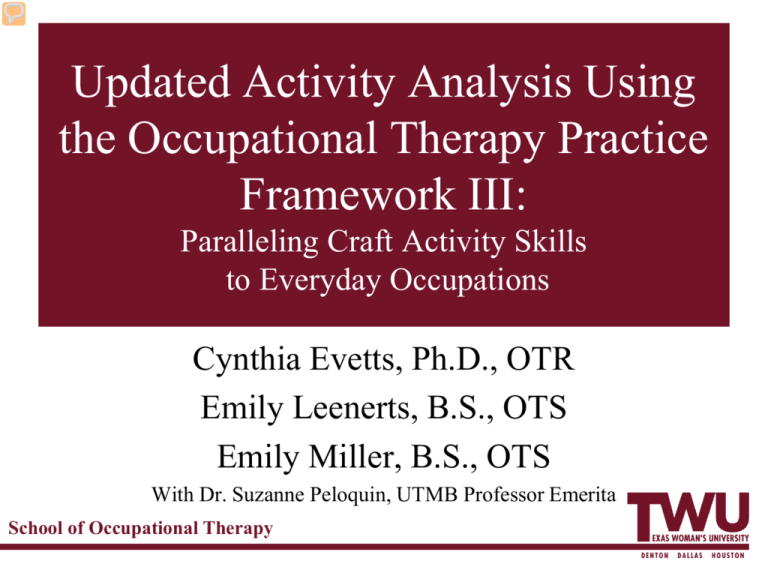
Updated Activity Analysis Using the Occupational Therapy Practice Framework III: Paralleling Craft Activity Skills to Everyday Occupations Cynthia Evetts, Ph.D., OTR Emily Leenerts, B.S., OTS Emily Miller, B.S., OTS With Dr. Suzanne Peloquin, UTMB Professor Emerita School of Occupational Therapy Outline and Objectives of Workshop Outline 1. 2. 3. Orient you to updates in the new OTPF-III Analyze your own meaningful occupations and discuss what other craft activities help to build related skills. Analyze a patient’s meaningful occupations and discuss what craft interventions help to reach functional outcomes. Craft 4. ----------break Explore the research with Emily Leenerts. Craft 5. Discuss tips to successful therapeutic use of craft. Craft School of Occupational Therapy Outline and Objectives of Workshop Objectives • Demonstrate activity analysis of craft activities and parallel skills to everyday occupations • Get you updated on current OT terminology • Collaborate on ADL analysis • Demonstrate documentation of craft intervention • Build confidence to use therapeutic craft activities as an intervention • Have fun! Share ideas! Ask questions! School of Occupational Therapy Orientation to the Updated OTPF-III • The purpose of the OTPF-III is to “describe central concepts that ground occupational therapy practice and build a common understanding of the basic tenets and vision of the profession”. • Two parts: Domain and Process – Domain: OT body of knowledge and expertise. • The “what” – Process: Client-centered evaluation and intervention. • The “how” School of Occupational Therapy OTPF-III Domain – Occupations – Client Factors – Performance Skills – Performance Patterns – Contexts & Environments School of Occupational Therapy OTPF-III Process • Evaluation • Intervention • Targeting of Outcomes School of Occupational Therapy OTPF-III Terminology: Important for Today’s Workshop • Activity Analysis: Analysis of “the typical demands of an activity, the range of skills involved in its performance, and the various cultural meanings that might be ascribed to it”. – Activity analysis is a distinguishing skill of occupational therapists that sets us apart from every other profession in the health industry. – We do activity analysis on a regular basis and we are good at it! – It includes knowing our client’s limitations and strengths, using skill-building interventions that are geared to reaching functional outcomes, and grading the activity to meet a just-right challenge. – We do this whole process within a reflective thought process while working with a client. School of Occupational Therapy OTPF-III Terminology: Components of Activity Analysis • Activity Demand: Aspects of an activity or occupation needed to carry it out, including: – – – – – – – relevance and importance to the client objects used and their properties space demands social demands sequencing and timing required actions and performance skills required underlying body functions and body structures • Performance Skill: Goal-directed actions that are observable as small units of engagement in daily life occupations. They are learned and developed over time and are situated in specific contexts and environment. – Motor skills – Process skills – Social interaction skills School of Occupational Therapy OTPF-III Terminology: Components of Activity Analysis • Activity and Occupational Demands • Relevance and importance to client • Objects used and their properties • Space demands • Social demands • Sequencing and timing • Required actions and performance skills • Required body functions • Required body structures OTPF-III Terminology: Related to Craft Interventions • Preparatory Tasks: Actions selected and provided to the client to target specific client factors or performance skills. Tasks involve active participation of the client and sometimes compromise engagements that use various materials to simulate activities or components of occupations. Preparatory tasks themselves may not hold inherent meaning, relevance, or perceived utility as stand-alone entities. Examples include: - Assertiveness training to prepare for self-advocacy - Hand strengthening exercises with therapy putty, exercise bands, and grippers. - Craft activities can be an example of preparatory task School of Occupational Therapy OTPF-III Therapeutic Use of Craft Occupation is both a means and an end! Therapeutic use of craft is more than just doing crafts. Crafts have preparatory elements, building proficiency in specific skills that directly relate to functional goals and outcomes. (Usually more engaging for the client than rote practice of ADLs.) Craft can be included in all five approaches to intervention: - Create, Promote - Establish, Restore - Maintain - Modify - Prevent School of Occupational Therapy OTPF-III What’s New? - Sensory - Emotional - Relevance School of Occupational Therapy renewal pleasure companionship coherence agency 12 things I like to do every day affirmation Occupational needs accomplishment Self-Assessment of Meaningful Occupations X Shower X Take the dogs for a walk Cook breakfast X X Email friends and family School of Occupational Therapy X Worksheet: Activity Analysis of Everyday Occupations Activity Analysis: Analysis of “the typical demands of an activity, the range of skills involved in its performance, and the various cultural meanings that might be ascribed to it”. Step 1: Activity analysis of the everyday occupation. What is required to do the task? Fill in the first column. Step 2: Select and analyze a craft activity that helps to build competency in the skills of everyday occupation. Fill in the second column. Pick one important everyday occupation: Driving to work (IADL) School of Occupational Therapy http://www.thevehiclesite.co.uk/blog-details/13/Dogs-that-can-drive Worksheet: Activity Analysis of Everyday Occupations Components of Analysis Relevance/Meaning Objects/Tools Space Social Sequencing Required Actions/ Performance Skills Motor Process Social Body Functions/ Body Structures Mental Sensory Musculoskeletal Speech Cardiovascular Other Everyday Occupation Driving to work Exercise independence. Important for community mobility. Car: Steering wheel, foot pedals for braking and accelerating, rear view and side mirrors, blinker signal to turn, chair Moderate room in cabin of car to move arms and feet. Everything in about arm’s reach. Rules of the road, respecting the space and signals of other drivers, respect speed limit. Turning on the car, checking mirrors, buckle seat belt, change gears. Sequence changing lanes or turning. - Grip the steering wheel, coordination of motor skills to move the steering wheel, keep body and head upright. - Scan the road for potholes and other drivers, plan your navigation or route, attention to the road and task, respond to unexpected traffic or car - Takes turns at a stop sign, socializes with passenger while not maintaining consistent eye contact - Alert and conscious, ability to focus for prolonged periods - Sensation of the wheel, proprioception, visual acuity - Upper extremity and lower extremity strength (use of arms and legs) School of Occupational Therapy Worksheet: Activity Analysis of Everyday Occupations Components of Analysis Relevance/Meaning Craft Activity Knitting Interest or hobby. Expression of creativity. Make gift for another person. Objects/Tools Yarn, knitting needles or loom. Space Moderately small space to work on project in lap or on table. Everything is within arms reach. Sharing supplies if in a group and cleaning up after you are done. Social Sequencing Required Actions/ Performance Skills Motor Process Social Body Functions/ Body Structures Mental Sensory Musculoskeletal Speech Cardiovascular Other School of Occupational Therapy Steps to position hand, yarn, and knitting needles. Turning needle and manipulating the yarn. - Fine motor manipulation, movement of the shoulder, elbow, and fingers. Coordination of upper extremity. - Scan for knots or tangles in the yarn. Plan steps to finished product. Respond to unexpected mistakes. Attention to task. - Alert and focused on sequence of task. Image the finished product. - Sensation of the yarn and needle, proprioception, visual acuity. - Upper extremity strength and ROM. Gross and fine movement Worksheet: Activity Analysis of Everyday Occupations Tips for craft: - Craft activity should be meaningful - Grade the craft for a just-right challenge - Outcomes of craft activity should be directly related to your goals http://dianne-jones.blogspot.com/2011_11_01_archive.html School of Occupational Therapy http://www.instructables.com/id/Make-a-Frame-Loom-for-Weaving/ Activity Analysis of Everyday Occupations: Group Work! Activity Analysis: Analysis of “the typical demands of an activity, the range of skills involved in its performance, and the various cultural meanings that might be ascribed to it”. Step 1: Activity analysis of the everyday occupation. What is required to do the task? Fill in the first column. Step 2: Select and analyze a craft activity that helps to build competency in the skills of everyday occupation. Fill in the second column. Pick one important everyday occupation:______________________________ School of Occupational Therapy Worksheet: Activity Analysis and Craft Intervention Client: 54 yr-old female with left CVA Occupation: Brushing teeth https://www.healthtap.com/user_questions/174095 School of Occupational Therapy Activity Analysis and Craft Intervention Components of Analysis Everyday Occupation Brushing teeth Relevance/Meaning Hygiene and self-care Objects/Tools Tooth brush, tooth paste, water, sink Space Good lighting, small work space Social Expectation from others to have a clean mouth. Sequencing Process of untwisting the cap of the tooth paste, applying tooth paste to brush, wetting tooth brush, back and forth motion in mouth to clean. Usually performed at morning and night. - Grip the tooth brush, squeeze paste from the tube, gross and repetitive movements of the shoulder, spits out saliva - Attends to task without distraction, uses tools for intended purpose Required Actions/ Performance Skills Motor Process Social Body Functions/ Body Structures Mental Sensory Musculoskeletal Speech Cardiovascular Other - Alert and oriented - Sensation of saliva in mouth and need to spit, not swallow or choke. Proprioception. - Use of one or both hands, upper extremity. Upright position - Automatically timed breathing so no choking occurs. School of Occupational Therapy Activity Analysis and Craft Intervention Components of Analysis Craft Activity Paper Heart Basket Relevance/Meaning Gift for another person, hold message, seasonal ornament Objects/Tools Scissors, paper, table to work on Space Good lighting, space for individual work area Social Sharing supplies, following verbal directions or cues, cleaning up after done Sequencing Follow sequence of steps, measuring, cutting and weaving. Required Actions/ Performance Skills Motor Process Social - Manipulates tools, manipulates paper to weave. - Uses tools appropriately, initiates step after reading instruction, finds mistakes - Asks questions when confused, asks to share supplies Body Functions/ Body Structures Mental Sensory Musculoskeletal Speech Cardiovascular Other - Orientation and attention to task - Sensation of tools and supplies, proprioception - Upper extremity movement. Gross and fine motor - Ask for help or communicate School of Occupational Therapy Activity Analysis and Craft Intervention Craft Intervention: Heart Basket http://radmegan.com/2010/12/weaving-danish-heart-baskets-for-jul.html School of Occupational Therapy Heart Basket • Occupational therapy is both art and science • Heart enhances the art of therapy – Values – Passion Activity Analysis and Craft Intervention Craft Intervention: Heart Basket 1. Cut construction paper into four even sections (hamburger style) 2. Cut the edges so each one is a long oval with rounded edges 3. Cut three parallel lines out of the oval shape, stopping an inch before the edge 4. Fold each oval shape in half and face the folds together so it resembles a heart shape School of Occupational Therapy Activity Analysis and Craft Intervention 5. Begin weaving with the top fold of the right oval. Thread it through the top folds of the left oval piece. 6. Make sure to weave the right fold you are working on through each left fold. This will help it look checkered, and also give the heart a basket shape. 7. Weave each right fold completely and move it up to begin the next. School of Occupational Therapy Activity Analysis and Craft Intervention Grade the activity by: - Using a different medium. Eg: felt, foam, or paper. - Precut the shapes, like we did for you today. - Give a premade sample to disassemble and assessable. School of Occupational Therapy Activity Analysis and Craft Intervention Tips for documentation: Use language that illustrates specific skill building in progress note. Track progress with measureable degree in mind (time, cues, etc.) LTG is related to occupation and function. STG is related to specific skill building (accomplished via craft). When using electronic documentation, focus on documenting the skill. Leisure activity or therapeutic exercise may be accurate categories, but may not give adequate credit to the skill building and functional outcomes. School of Occupational Therapy Activity Analysis and Craft Intervention Document Goals: LTG: Client will perform morning teeth hygiene using both hands by end of two weeks. STG: Client will demonstrate use of affected hand to stabilize and grasp objects during skilled, purposeful task. STG: Client will demonstrate reduced neglect of affected arm by using it in 40% of activity with verbal cues. Document Progress: Subjective: “My bad side can help out a little bit more today”. Objective: Client lifted affected forearm to table with use of unaffected hand with no verbal cues. She held the paper heart with her affected hand and manipulated the paper weaving with her unaffected hand. Assessment: Client recognized progress in use of affected hand. Client demonstrated gross motor weakness in affected arm and functional use of fingers in affected hand. Plan: Progress towards goals met through the use of crafting. Continue to use skillbased craft modality for this client. OR … Progress towards goals not met through the use of crafting. Discontinue use of skill-based craft modality for this client. School of Occupational Therapy Activity Analysis and Craft Intervention: Group Work Client: ___________________________________________________________ Occupation:_________________________________________________ Step 1: Activity analysis of the client occupation. What is required to do the task? Fill in the first column. Step 2: Select and analyze a craft activity that helps to build competency in the skills of this occupation. Fill in the second column. School of Occupational Therapy Research http://ihealthtran.com/wordpress/2014/08/research-shows-effectiveness-of-emr-in-positively-impacting-clinical-outcomes/ School of Occupational Therapy Is Craft Relevant among Adults? • Introduction – Craft was part of occupation-based treatment in early history of OT (Bathje, 2012) – Craft fell out of favor during Reductionist Movement (Christiansen & Haertl, 2014) – Full-circle, are we returning to craft? School of Occupational Therapy Social Media Research • Social Media Research data (Guistini, 2010; Lomborg, 2012; Wu, Sun, & Tan, 2013; Jacobson, 2011) – Pinterest selected; craft is popular topic http://pro.psychcentral.com/private-practice/wpcontent/uploads/sites/2/2014/09/oa4qcmjpg_zpsf989836b.png Study Methods • 6 weeks, 4 hrs/week on Pinterest • Data gathered – Crafts from commonly found materials in clinics, inexpensive (<$1) materials at craft stores, or recycled materials – Other criteria Gender Female-oriented www.buzzfeed.com Neutral www.babble.com Male-oriented www.craftgawker.com Age Young Population Neutral Mature Population www.babble.com de-tout-et-de-rien-caroline.blogspot.ca www.pinterest.com/CristinaKopecky Conditions Changing Laterality marisa-ramirez.tumblr.com Low Vision www.indianainking.blogspot.ca Weak Pincer Grasp www.cfabridesigns.com Decreased Memory www.mysocalledgreenlife.com Holidays www.smcarney.blogspot.com www.embraceyourchaos.com http://www.pinterest.com/Patriciuca/ Meaningfulness www.naturallife.com www.marthastewart.com www.marthastewart.com Playfulness and Joy www.blog.honest.com www.playbasedlearning.com.au www.moonfrye.com www.redtedart.com www.pinterest.com/mobileprofessor www.homemadesimple.com www.craftsncoffee.com Crafts can be adapted! www.buzzfeed.com http://www.pinterest.com/Patriciuca/ Using Craft • Fortune Cookie Craft – Many ways to adapt craft – Portable, clean • Instructions found in bag with materials http://www.dumpaday.com/wp-content/uploads/2014/01/do-ityourself-crafts-14.jpg Fortune Cookies • Good fortune comes to those who…. • Pay it forward – Write a piece of advice for good occupational therapy Advocate and Promote Therapeutic Use of Craft in Your Work Setting: • Crafts don’t have to be a huge project. Try incorporating creativity into the intervention. Example: Have patient peel off own paraffin wax and create a figurine. • Petition to your department director for basic supplies. • Barriers to not using craft activities might include a personal lack of knowledge about craft. Therapists tend to use interventions that their facility endorses or that they are more familiar with. Be open- craft is simply creating. • Understand your client. What craft activities are meaningful to them? • Use documentation to demonstrate the usefulness and efficacy of therapeutic craft activity. Focus on skill building. School of Occupational Therapy Butterfly or Moth http://en.wikipedia.org/wiki/Viceroy_(butterfly) http://www.edupic.net/leps4.htm School of Occupational Therapy References American Occupational Therapy Association. (2014). Occupational therapy practice framework: Domain and process (3rd Ed.). American Journal of Occupational Therapy, March/April 2014, Vol. 68, S1-S48. doi:10.5014/ajot.2014.682006 Bathje, M. (2012). Art in occupational therapy: An introduction to occupation and the artist. The Open Journal of Occupational Therapy, 1(1). Christiansen, C. H., & Haertle, K. (2014). A contextual history of occupational therapy. In B. A. B Schell, G. Gillen, & M. E. Scaffa (Eds.). Willard & Spackman’s Occupational Therapy (12th ed., pp. 9-34). Philadelphia: Lippincott Williams & Wilkins. Giustini, D. (2010). Building research capacity among a group of social media adopters in Canada: introducing the Social Media Research Team (SMeRT). Journal of the Canadian Health Libraries Association, 31, 119-121. Jacobson, J. (2011). Leveling the research field through social media. American Journal of Nursing, 111(10), 14-15. Lomborg, S. (2012). Researching communicative practice: Web archiving in qualitative social media research. Journal of Technology in Human Services, 30, 219-231. Wu, J., Sun, H., & Tan, Y. (2013). Social media research: A review. Journal of Systems Science and Systems Engineering, 22(3), 257-282. Questions and Comments? Thank you for your participation! Get Crafty! School of Occupational Therapy Contact us… • OT@TWU.edu

